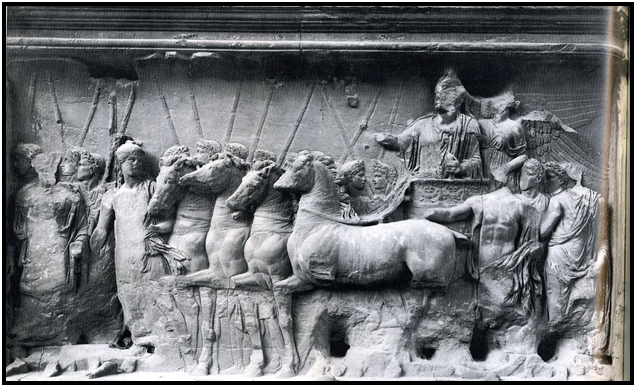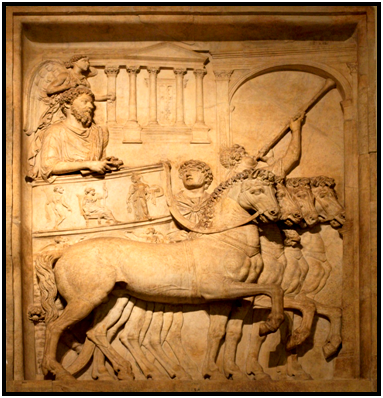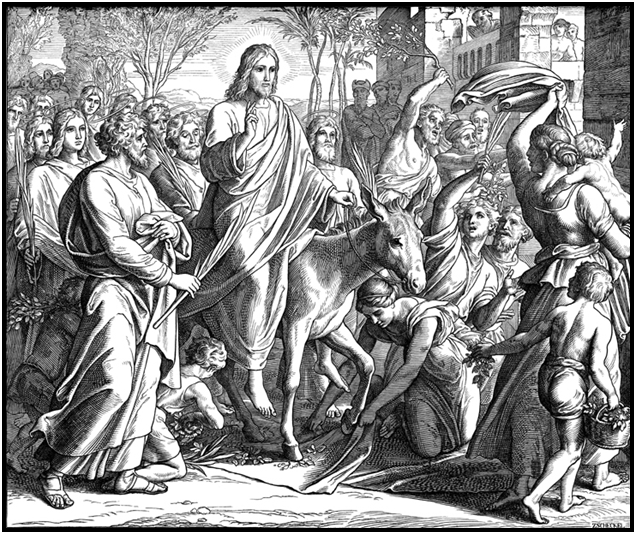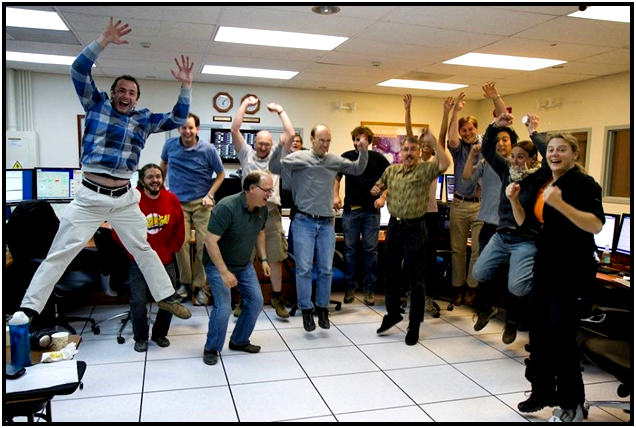May 2014 Forecaster Newsletter
Rocks, Water, Tigers, and Mice
ROCKS, WATER, TIGERS, AND MICE
A Sermon Preached by the Rev. Dr. Arthur M. Suggs
On Sunday, March 23, 2014
Moses Strikes Water
We have just heard a reading from Exodus 17. It’s a beloved story, near the middle of the entire Exodus chronicle, in which the children of Israel are wandering in the wilderness, and they begin complaining because they are thirsty. That’s understandable, I suppose. If you were wandering in a desert and with you were women, children, old people, and a lot of baggage, of course you would get thirsty. So Moses strikes the rock at Horeb with his staff, and out comes water. The people are saved once again.
This story works on a number of levels. It works as a basic narrative in that you’ve got a really strong bad guy, the antagonist in the person of the pharaoh, with his people and the army chasing the Israelites. And you’ve got a really good guy in that Moses is powerful. He’s got great connections. But he’s also flawed. It’s a compelling saga that holds your attention and your interest in what happens to the people.
The epic also works beyond basic narrative at the magical level. Supernatural, mysterious things are going on. Moses’ staff will be used to save the people from poisonous snakes, and he used it to free the people from Egypt. You might envision Charlton Heston in his flowing robes holding the staff, or you might picture Gandolph and the way he’s constantly saving the Fellowship with his staff.
Go Deeper, to the Archetype
But I would ask you this morning to go down yet one more layer to the archetypal level. There’s some deep symbolism going on here, the opposites of desert wilderness and water. There’s an old expression of being caught between a rock and a hard place. Well, a desert is a hard place full of rocks. It’s both. It’s hard, it’s dry, it’s unforgiving, and it can be deadly. Traveling through the desert can be dangerous and burdensome. Water is crucially important. It symbolizes the opposite – softness, life, refreshment, coolness, growth – all made possible by water in an unforgiving environment such as a desert.
Coming into this archetypal setting, travelers encounter the opposites of the danger of the dry desert and the need for water to stay alive as they pass through it. In the context of this story and as multiplied by others, we get a take-home message not only from this vignette but also from the whole story of the Exodus: It is that God sees, God hears their complaints and prayers, and God cares. God can solve any problem.
If you’re a bunch of slaves, unarmed, burdened with baggage, cattle, old people, children, and you’re fleeing an army on horseback and in chariots, you’re in quite a pickle. Yet God saw, heard, cared, and delivered them. Saved them by parting the Red Sea, or the Sea of Reeds. Now you are in the desert, and you’re in trouble again. God sees, hears, cares, and delivers the Israelites yet again. Moses, hit that rock with your staff! And out comes water, miraculously.
The take-home message? If God can solve those two dilemmas, God can solve any problem.
Can You Really Take That Message Home?
Hold on just a minute. Is the take-home message really true? Is it believable? Are you convinced? Are you persuaded so far that God solves such problems?
Let me give you four contrary examples:
1. What about a 48-year-old middle manager who lost his job in 2008, right at the beginning of the economic downturn, and has been chronically unemployed or underemployed ever since? About two years after he lost his job, the marriage started to fall apart. They had to sell their car and get a cheaper one. They had to sell their house and move into a less-expensive place. They had two kids, who continued to grow up.
Eventually the marriage dissolved. He still can’t find work, and – this is probably the part that hurts the most – his two kids view him as a loser. Several years have passed, and he’s now in his mid-fifties, that stressful time of trying to find a career-level job. So he gets by on a McJob and his heart is broken. He loved his wife, and he loves his children, all of whom don’t think very much about him.
2. Or what about the parents of a teenager who seems hell-bent on trouble. We’ve all known this kind of teenager. Some kids are like that, rebellious and anti-authority to their very core. Much more interested in drugs, sex, or alcohol, completely at the expense of school and studying. Totally opposed to a job, making some money, saving for college. Wholly against any delayed gratification. The parents are worried, really worried. Deep inside, they’re not sure that this kid is going to be okay, that he’ll end up someplace bad. And they worry.
3. Or fathers of preschool children. Think of a single parent who lost his wife, their mother, to breast cancer while she was in her thirties. I’ve known three of these fathers in my time, all with similar stories. And for all three there is a hardness, a bitterness in their hearts.
4. Finally, consider a case of the second wife. A man marries young, and it’s not a good marriage. It lasts only a few years. Then, after the divorce, he’s single for a time until he meets a new person who is much better-suited for him, a much better marriage. They end up being married for nearly thirty-five years when he has a very sudden heart attack and is gone before anybody knew what had happened. Next, after the funeral when the second wife starts dealing with all the affairs of having lost a husband, she discovers that he never changed his will.
This is one of those old-fashioned families, in which the house was completely in the man’s name. Both cars the same. The investment accounts, the retirement accounts, yes, all in his name. A phone call is made, and the original wife from thirty-five years ago is finally found and informed that she has just inherited quite a bit. I’ve known two of these second wives to whom this has happened. They experienced sadness and bitterness and anger – serious anger that has settled into the hearts and minds and souls of those two women.
Now think about these four examples: a 48-year-old middle manager whose kids think he’s a loser, the parents of a hell-bent teenager, the fathers of preschool children who are suddenly motherless, and two bereaved and bereft second wives. Do you tell these people the story about Moses striking the rock in the wilderness and out comes water? Do you tell them that God can solve any problem? Would you tell them that? Would you look them in the eyes and say, God sees, hears, and cares? God can solve any problem? What would be their response to you?
Now I’ve Painted Myself into a Corner
Which is it? God sees, hears, and cares, can solve any problem? Or is there really an inherent sadness, bitterness, anger in our world? Is there any resolution between these two poles?
Relevant to this predicament, I would like to read you a story. It’s very simple, Zen in nature. For years I have enjoyed reading yarns from two different religious traditions, Hasidic and Zen. Even though I relish them, I’m often disappointed. Sometimes they purport to be deep and meaningful, but I just don’t get it. They may seem rather silly or shallow instead. However, I enjoy reading them, and I came across one that is in my opinion one of the deepest stories I’ve ever come across. It didn’t appear that way to me at first, and it probably won’t seem that way to you at first, either. But once I started looking into the tale, I began to get it. It’s called The Parable of the Strawberry:
A man was wandering in the wilderness when a tiger appeared and began to chase him. Panicked, the man fled and came to the edge of a cliff, with this ferocious tiger on his heels. Spotting a thorny vine rooted on a rock, he swung himself down over the chasm. Above, the tiger roared and pawed at the rock. And then, looking down, he saw the gaping jaws of a second tiger, pacing below him. Apparently these two worked as a team, and he didn’t know it.
Looking up at the first tiger, looking down at the second, the man noticed suddenly a white mouse and a black mouse that had appeared and had begun to gnaw away at the vine. But the man did not care. He no longer paid attention to the two tigers or the two mice for he had found a plump red strawberry growing on the face of the cliff. Holding onto the vine with one hand, he plucked the fruit with the other and popped it into his dry mouth. Oh, how sweet it was.
That’s the end of the story. I came across it in a Zen children’s book, and believe it or not, it’s also a pop-up book. As you open and close the page, you can see the man on the vine with the tiger below jumping up and the tiger above trying to reach down to get him. I’m not sure how advisable this book really is for small children, to be honest with you. Anyway, there it is. An ancient story, well over two millennia old.
Here’s an Interpretation of the Parable
The tigers. The first tiger that began to chase the man represents the problems of your youth, of your childhood, if you remember those times. For example, when you had a crush on one of the other students in class your heart was broken for the first time in your life. Or if you were at all like me, I was a mouthy kid and got myself in trouble. And I got myself beat up or sent to detention multiple times in my school career. Or dealing with your parents, those “stupid” parents every kid has.
The tiger below, into whose jaws the man will fall, represents the problems of your old age. Feebleness, failing memory, all sorts of ways in which your body begins to let you down. Being in the hospital, needing surgery, falling and breaking a hip. Then you can’t remember things, and it seems as though sometimes the only correspondence you get is information about some old friend who has died. Not always golden years for some elderly people.
Then the two mice, one white and one black. There is something typically Zen about the story in that the white mouse represents the good things, but the “good” things that happen to us, according to Zen tradition, aren’t always so good. For example, a man gets a promotion and a raise, and now he is further entrapped by a job that’s not so good for him. But now that he’s got a promotion and a raise, it’s all the more difficult to leave the job and make a change in his life.
The black mouse represents the bad things that can happen in our lives. But again, in the Zen tradition, “bad” might not necessarily be so bad. Like the famous story of the young man who fell off a horse and broke his leg. That would be bad, except that two days later the army came through conscripting all the young men to go away to war, but they didn’t take him because he had a broken leg. So what’s bad and what’s good isn’t always so clear, and that’s why both mice are gnawing away at the man’s vine.
So What’s It All Mean, Man?
Here’s a deeper explication of the story: Hanging on that vine is the predicament of every human being. And for every single one of us, in front of our face is a strawberry. There is no interpretation for the strawberry because what it means is what it means to you. The strawberry represents the desire of your heart, the longing of your soul, and it’s different for every one of us. You have to decide what the strawberry means to you.
All of us can be distracted by our perils. Those four examples – the 48-year-old middle manager, the parents of the teenager, the father of the preschool kids, the second wives – those four were very much distracted by the tiger above and the tiger below and the two mice chewing on the vine. They were so distracted that they probably never saw the strawberry in front of their faces.
And the children of Israel wandering in the wilderness? Yes. They were definitely distracted by the tigers and the mice, complaining as they went and not seeing the strawberries along the path. All of us can be distracted by our perils. The two tigers and the two mice are the common lot of all humanity. But so is the strawberry.
Amen.
REVISING EXPECTATIONS — FINAL
REVISING EXPECTATIONS
A Sermon by the Rev. Dr. Arthur M. Suggs
Preached on Palm Sunday, April 13, 2014
Instant Karma Will Get You Back
The sermon is a little unusual this morning in that it is both for the children and also for the adults, so wish me luck. I was ill last week, and one of the consequences of being under the weather is that I spent a bit too much time surfing the net. I came across a website that was tears-in-your-eyes funny, having to do with what’s called instant Karma.
Do you know what Karma is? It’s a notion that, if you send out something bad, bad comes back to you. So if you put out a bad word, a bad thought, or especially a bad action, bad sort of finds its way back to you. Not always instantly, but like oatmeal, sometimes there’s instant Karma. Other times it takes a while, but it always comes back. The same thing happens with good. Good words, good comes back to you. Good actions, good comes back to you.
So this website was about instant Karma. The story involves an unsuspecting girl standing in a gym class facing the bleachers, which had been pushed back against the wall to make more space on the floor. She’s minding her own business when another kid, a little bigger than she, begins sneaking up behind her holding one of those pink balls that you find in gym classes. He’s getting ready to hurl the ball at the back of her head. A perfect target, facing the other way and completely unaware.
Now is that a nice thing to do? No. Okay, it’s funny. I’ve done it before, I admit. But it’s still not nice to sneak up behind somebody and throw a ball at the back of their head.
Nevertheless, that’s what he’s fixing to do. But just at the very moment he cocks his arm to fire the missile, his target suddenly stoops down to pick up something off the floor. He lets go with a fastball. It just grazed the top of her hair so she noticed it but was not hit by it.
Instead, the ball hit the bleacher hard, rebounded straight from a board on the bleacher, whizzed right over the girl’s head back to the thrower, and smacked him right in the face.
That’s instant Karma.
An Angry Driver Stars on Camera
Another story on this website was also reported on the news about a woman who was driving in Florida. She’s minding her own business driving along, when she sees behind her a pickup truck whose driver is really mad trying to get past her. Flashing his lights, honking his horn, trying to get around. She’s going the speed limit so she’s not really motivated to go a lot faster for this guy. It’s like, deal with it. However, he’s evidently so angry that she whips out her cell phone, which has a camera, and within moments she is videoing him.
With her left hand, she aims the camera over her right shoulder through the rear window while steering with her right hand, looking in the rearview mirror, watching the truck, staying on the road, and driving normally. All the time she’s videoing this guy.
Well, the next thing you know, her single lane widens into two lanes. The woman stays in the left lane. The pickup truck swoops into the right lane before she can move over, and instead of just passing, he pulls up beside her and makes an obscene gesture. It was a negative thing, a very mean gesture. By this time, though, she’s filming the guy through her passenger window and catches it all on camera.
Suddenly, in a steaming fit of self-righteous rage, the guy tromps on the gas pedal, zooms leftward in front of her, and cuts so hard that he loses control and goes spinning down onto the median between the roads.
The woman slows down and continues videoing as the guy goes off the road. She got his license number. She got his face when his hand wasn’t in the way. She filmed the whole thing and sent it to the police.
That’s instant Karma.
Two Birds Hang Up and Crack Up
This one made me remember a case of instant Karma that I saw myself. I was walking toward Bon-Ton’s in the mall, about ten feet behind a pair of girls. They were together on one phone call, leaning close to each other so as to share the phone while talking to a third person on the other end and paying no attention to their surroundings. We’re getting close to Bon-Ton’s entrance.
It was a very energetic conversation. I couldn’t hear the words, but the two were extremely upset about something and were intent upon their conversation. Finally, as they neared the door, the girl holding the phone hangs up abruptly, turns to her friend, and explodes with some very profane words.
She had called the party on the other end a string of very bad names and was heatedly recounting them to her companion at the very moment the two of them strode obliviously into the plate glass doors of Bon-Ton’s.
That’s instant Karma.
Karma in a Four-in-Hand or on a Donkey?
I have just given you three cases of negative Karma. It is equally positive, though, and I want to give you an extraordinary example of putting good Karma out into the world and good coming back.
First let me set the scene for you. The first three pictures show modern armies marching. For comparison, the fourth image represents the ancient army of the Roman legions.
The Chinese Army Marching
The North Korean Army Marching
The United States Army Marching in Iraq
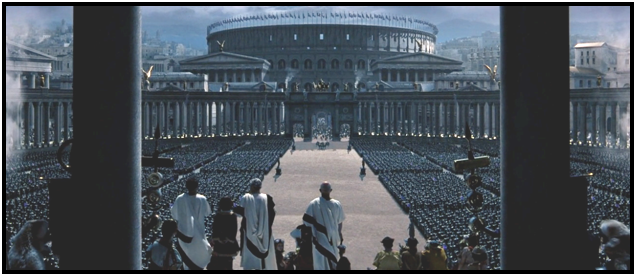 The Roman Legions Entering Rome (from the Movie “Gladiator”)
The Roman Legions Entering Rome (from the Movie “Gladiator”)
The three preceding modern armies are all modeling themselves after the Roman legions pictured above.
You may not recognize it right away. Have you ever seen the movie “Gladiator”? Okay, many have seen that movie; it was very popular. This is an early scene showing the triumphal entry of the Roman legions into Rome after it had battled to an overwhelming victory against the Germanic tribes in northern Europe. They were completely routed by the Roman legions.
Those legions then returned to Rome. They celebrated their military victory by staging a parade as they entered the city upon their return. In the front of the picture are the Senators, and in the background is the Colosseum. On the sides are the soldiers, all in battle array in a massive display of force and power and armament. In the back, on the other side of the pillars, is the crowd.
The conquering general is in the middle of the picture, standing in a chariot drawn by four horses. He is receiving tribute for their victory and will soon make his way amid thunderous cheering up to the Emperor, who is there with the Senators to receive the glory and accolades deserved for the triumph.
Modern Armies Model Roman Practice
Armies to this very day emulate this ancient practice that goes back many ages to the rise of the Roman empire.
Now I want you to think for a moment. Compare the next two pictures. The first one shows the Emperor Titus in a bas-relief carved into his sarcophagus. It’s over 2,000 years old so there’s a lot of damage, but you can see the chariot and the four horses.
The Sarcophagus of the Emperor Titus
Marcus Aurelius with an Angel on His Shoulder
The immediately preceding picture is a relief depicting Marcus Aurelius, who happened to be the Emperor portrayed in the movie “Gladiator.” Here he is seen entering the city of Rome as the conquering general and emperor, with four horses and a chariot.
The reason I wanted to show you this particular picture is that there’s an angel perched on Aurelius’ shoulder. In Roman times that angel, who is depicted as giving the general divine advice for victory, was named Genius, from which we derive the modern word.
What Was Jesus’ Message About the Donkey?
Now compare all of these Roman and military scenes to the following picture from a Sunday-school book about Palm Sunday.
Jesus Entering Jerusalem on a Donkey
The question I would like you to ponder is why Jesus entered Jerusalem riding a donkey. Everybody knew the proper way to enter a city to reap the glory of victorious battle. Why did he do it this way? There are no armaments at all. Nobody is in Rome, following their rank. There are women and children and old people and young people.
Why did Jesus enter on a donkey rather than in a chariot drawn by four warhorses? What was he trying to get across?
I would like to answer this question for you, but I really shouldn’t. It would be like telling the punch line to a joke. It’s more appropriate for you to answer the question yourself when you compare the Roman way of entering a city with Jesus’ way of entering Jerusalem. What is in your heart is what’s right for you at this time. I can give you a Biblical answer; I can give you a theological answer. But it would only be my answer. You have your own thoughts about why Jesus entered his city in his own special way.
A Renaissance Woodcut of Jesus Entering Jerusalem on a Donkey
This picture shows the same kind of thing as the one before it – the donkey, average people, a chaotic crowd. It’s not orderly, there are no armaments, no chariots, no spears, no tanks. Once again, why did Jesus do it this way? What was his message?
Now I want you to hang on to the answer you have developed about why he did this. Just put it in your short-term memory for a moment while I tell you two more stories. Then I’m going to ask you to think about three things – the answer you have formulated in your mind as to why Jesus entered Jerusalem in a special way and the following two stories. I’ll ask you to put the three together. It’s not going to be easy, but I want you to try.
Don’t Drop It, Tom; It’s Very Very Heavy
This story is much different, an extraordinarily rare photographic image. Back in January, it was published in all sorts of scientific journals. It is the very first image ever seen of another planet outside our solar system. They’re called exoplanets. We’ve got pictures of Jupiter, Mars, and others, but they’re all in our solar system, all nearby. Here is a planet orbiting a star that is nevertheless very close to us in terms of the cosmos. Our nearest star, the sun, is four light-years away. This one is 63 light-years away.
Photo of an Exoplanet Taken at a Distance of 63 Light-Years from Earth
This exoplanet’s sun is the big dot in the middle of the photo, but the blue area that’s all around it in the center, where all the brightness of the star should be, is blocked out by software. The planet is the little white dot at the bottom right. It’s about 32-60-some pixels wide, and that’s as big as it is.
By the way, here is a picture of the team of astrophysicists rejoicing at the existence of this photograph. They say this exoplanet is 63 percent larger than Jupiter and is obviously very close to its sun.
Astrophysicists up in the Air at Success of Photo Taken at Incredible Distance
Here’s a planet that should be extremely volcanic due to its proximity to that sun. The gravitational forces of a huge planet so close to a giant star would have to be incredibly strong. This planet is therefore being squeezed and pulled, and squeezed and pulled as it orbits around this sun. The two bodies are very close to each other, and both are enormous. For comparison, Jupiter is our biggest planet, and the newly pictured planet is 63 percent bigger than that. So we’re talking about a very volatile place, larger than Jupiter and 63 light-years away.
I pulled out my calculator. Taking a photograph of that planet would be like making a photograph of your face except that your face would be two-thirds of the way to the moon. It is the equivalent of taking a photograph of a grain of sand except that the grain of sand is in Los Angeles. Also, I want you to appreciate the technology and science that were necessary to take this photograph.
Now please turn around and face the rear of the sanctuary. There’s Tom, one of our deacons, standing in the back of the sanctuary. When he went out to ring the bell this morning, I asked him to bring in a single grain of sand, and he’s holding it up for you to see. You can’t see it? Okay, he’s holding the grain of sand; you can guess how big it is. “All right, Tom, it represents a huge planet. Just don’t drop it.”
Now if I were to whip out the little camera on my phone and take a picture of the single grain of sand, would you be able to see it? No, not even close, and it’s only a few yards away. So imagine the special camera, the science and technology that enabled the astrophysicists to take a picture that ended up giving us a view of a grain of sand, except the grain of sand is in Los Angeles.
That’s what this photograph is like, and it’s the first time it has happened in the history of humanity. It should be in a church, if you ask me.
Female Quail Sacrifices Self to Brood
One more story to tell you. Does anybody know what this picture shows? It’s a quail, a male quail on the right, and the female on the left. You’ll notice that the male is better looking – one of those universal things in nature. (Um-m-m. Uh-h-h. Ha!)
Female Quail at Left; Male Quail at Right
Quail Chicks
This story happened last summer. There was a heat wave out West, and in northern California there was a big forest fire. After the fire had burned through and was put out, some rangers were cleaning up debris where the fire had gone through.
Up against a tree one of the rangers spotted a quail. It was completely black. It had been burned but was still standing right up against that tree with all its feathers completely charred. The whole bird was thoroughly blackened. The ranger went over and touched the quail, but it didn’t move. It just toppled over, and out from underneath the hen waddled three little chicks.
What the mother hen had probably done was to make a terrifying choice between fleeing the fire and abandoning her covey or choosing to stay to try to protect the flightless brood. Her choice was a primal one. She opened her wings, the little ones climbed underneath, and all four stood by the tree awaiting the fire.
The fire came roaring down over them. The mother quail died. Her chicks lived.
What I want you to do now is to put these three images together. Try to imagine the kind of love the mother quail had for her little ones, and combine that thought with the kind of tenacity, the kind of technology, the kind of human force that we can put behind a project to achieve something important to us. And to succeed at accomplishing a significant undertaking such as a photograph of a planet 63 light-years away.
Then I want you to meld those two ideas and join them with the concept of humility, of nonviolence, of a desire to change the value system of a violent society. To upend the way in which people routinely do business, to know that the prince of peace rides in on a donkey, not being drawn in a chariot by four stallions.
If we would take that message and combine it with unconditional love and the fortitude of which human beings are capable, that, my friends, is what Palm Sunday is about.
Amen.
Franchising Christ
Audio Versions of this Sermon by Rev. Dr. Arthur Suggs
128kbps
32kbps
Know Me
KNOW ME
Preached on Sunday, March 30, 2014
A Sermon by the Rev. Janet L. Abel
Getting Started
This sermon is entitled “Know Me,” and I would start by saying I believe that to be known is nearly as deep a need as water.
Those of us who attended college were compelled to pick a major, usually in the junior year, in a field of study in which our knowledge would flourish. I picked economics but am not sure why. Perhaps because I thought it would be practical. My interests led me to English, literature, history, and religion, but my parents said I really should be practical. So I started out with biology but quickly changed my mind. Art is far more scientifically-minded than I am, and I knew enough to pick something else after taking several courses in science, so it was economics for me.
Going to graduate school required further, more concentrated studies, which led me to aim for a school that was focused on an area specific to my interests. I decided to go for a Master of Divinity degree. Although the name implies that those who go to seminary, like Art and me, will become masters of divinity, I don’t know that one ever masters anything like divinity.
Even so, how we come to know God and come to our faith is a unique story for every one of us.
Our Different Stories
Art’s story, as he’s told us, is one of math and science, that the beauty of mathematical equations led him into his faith. I traveled a far different path. I admit that I prayed a lot in math class to pass, among other things, but I didn’t quite see God in my study of math. I was more panicked. It’s numbers and I. I don’t even do Sudoku. Numbers just don’t speak to me.
My faith developed differently. Through people, to be honest, and animals. The need to take care of our pets at home. Visiting the hospital and the nursing home. Setting the communion table for church. My Sunday-school teachers, my parents. Learning the stories of people who lived long ago – David and Solomon and Joshua, Leah and Rachel, Moses, Jesus and Paul, Peter and John. Music also has a big part to play in my faith. And art, including photography.
As a little girl we always got National Geographic, and I loved looking at the pictures although at first I didn’t read it. I viewed Mutual of Omaha on television, watching animals get tagged. I remember men in particular sitting in the bush keeping an eye on other animals, taking pictures of elephants and tigers. And the movies. I admit that a great deal of my faith formation as a child came from King of Kings, Ben Hur, The Robe, and The Ten Commandments.
I know Art has quoted Einstein heavily in his sermons, and I have yet to do that. I don’t know that I fully understand E MC2, and maybe that is a blessing, but I have quoted names in Cabaret, and I’m working on others.
We do come to know ourselves and each other and God in different ways, and that’s okay. It’s a wonderful thing, really, and we believe differently as well. That too is okay. How do we keep learning, keep our knowledge growing? Many of us might watch a special on television or go to see a certain movie, and we’re compelled to learn more about a certain subject. You get the relevant books out of the library or order them and then read and reread, study and relearn.
As a kid, history bored me silly. It seemed to be a series of wars and dates empty of excitement. Yet now I love it and spend more time reading about people, events, and happenings. I read about Scotland and the year 1776 in our nation, about the Johnstown flood in Pennsylvania and about Alexander Hamilton. You name it. You have too, I’m sure, and my knowledge about these subjects, people, and events has grown some.
I enjoy biographies as well, having just read three very different books in a row: Steve Jobs, I Am Malala, and Joan of Arc. I realize that’s quite a list. It runs a gamut, in both age and people. Just now I want to talk a bit about Steve Jobs. It’s a new biography for Steve Jobs’ life story and the founding of Apple.
The Steve Jobs Story
It was an interesting read. I learned a little more not only about Steve Jobs the man but also about Silicon Valley and how personal computers really got started. This huge explosion of personal technology affects us all as we acquire smart phones, iPods, and the like. Jobs himself wanted a thousand songs in his pocket. Think how revolutionary it was when he and his team came up with the iPod, which has turned the music industry upside down and has changed how we browse the Web.
Jobs had a particular challenge, as his biographer put it, in coming up with products that we want before we know we want them. When products by Apple came out, people would watch and say, I want that. It’s sleek, and it’s cool-looking. Feels good in the hand. Product development at Apple proceeded in a room with a table filled with facsimiles of new products that Steve and his team played with. They would walk around examining prospective products, holding them and putting them up to their ears. They had to feel good as well as look good and be endowed with strong technical advances.
Steve was also a difficult person. As described by his biographer, he had a nasty edge that hindered more than helped him. He had more than an edge. He was truly offensive. Who knows why? Jobs was adopted, and he felt that keenly. However, he ended up meeting his birth mother and his biological sister, and he and his sister became very close.
He hurt a lot of people, often being devastating in business and distant at home. A factoid about Steve Jobs tells you a lot about the man. Every day he would go to work in his car without license plates. He refused to put them on and would park crooked in handicapped spots every day. That’s the kind of guy he was, and that’s before he got sick.
Knowing and Caring Are Divine Acts
So why talk about this? I have come to understand, thanks to our passage in thinking about it, that knowing is a divine act. It’s an act of love. It’s an act of God. Here in church we all talk a lot about love. (I do too.) God is love. We have to love one another as we love ourselves.
And sometimes it’s good to think about love in practical terms. How do we show love? How do we give love? How do we feel love? One of the facets of love is to know and be known. Knowing takes time. Takes interest. Takes study. Takes caring. You do have to care and take the time to get to know one another right here in church.
Practical Magic
I’m going to tell you a simple story that I told the residents of the nursing home where I work as a chaplain. It’s called “Practical Magic,” and I’d like you to think about taking the time to know somebody. It’s by a woman, a granddaughter named Christy Caballero. The people on the corridor didn’t know. How could they? Nurses and doctors and orderlies, interns and patients, all in a rush to get someplace. While some hurry from point A to point B, others move in slow motion, measured steps, their grip on the handrail turning their knuckles white.
Glancing into the nondescript room as they pass by, people would have seen a gray-haired patient, looking like a grandfather in his 60’s, and they might have noticed a pretty young raven-haired woman sitting near him, about the right age to be his granddaughter.
But none would understand the miracle taking place in this drab world. It was subtle and easy to overlook, mistaken for a typical visit between a patient and a visitor, probably a family member. Yet it wasn’t typical. It was magic of a potent, all-too-uncommon kind, far too important to detect in a passing glimpse. As the moments passed by, the frail man painted pictures of his lifetime. His words were his brush strokes, and that was only half the magic.
The real magic was that the woman listened and heard him. The clock of his life was winding down. He struggled to walk across the room, but his words still had power. So it was with words that he whisked his visitor off to times long past and places that were half a world away. Times and places that he hadn’t been able to take anyone to for a very long time now.
His family didn’t mean to keep the man in a box. They were just too busy or too preoccupied with his illness. Take a break and meander into the room along with the staff. They already knew his stories backwards and forwards, but they didn’t understand that he had to share his memories so that in sharing them he could feel alive again.
The Patient Spreads His Wings . . .
As the woman sat in the sturdy, no-frills hospital chair, she listened. The man stood in the footprints of a lanky high-school boy, ashamed that he hadn’t ever left the state of Oregon. On his eighteenth birthday, there was only the lazy Columbia River between him and the state of Washington. He dove in and swam hard enough to reach the other shore. After collapsing and resting for a while, he swam back. He rooted about in his memories and found every treasured arrowhead over again. And he lived the rescue of a long list of injured animals.
As the minutes passed, the man turned into that tender recruit who went to World War II in military service. On the day two of his buddies were drafted into the army, he decided he wanted to determine his own destiny, and he enlisted in the navy. The only obstacle was the 60 miles between him and the recruiting station.
It was a bitterly cold winter day, and he turned his face toward Portland. He climbed aboard his bike with big fat tires and pedaled. And pedaled all night. The hours passed by as he froze. Stopping in a Portland diner, the young man counted his change and ordered a chili. It was the only thing he could afford. His navy stories were rich and vivid, full of Australia, a country he came to love. And the visitor saw him at his best, the way he was before the world wore him down.
The patient saved his most precious story for last. He sank back into a day in Norfolk, Virginia, walking along a street, making his way back to his submarine to ship out. He suddenly spotted a woman who instantly took his breath away. He didn’t even know her, and he didn’t get the chance to meet her. But somehow she made his heart ache. His heart ached for that lovely stranger for another decade until the night he met that same woman face-to-face at a dance in Alaska, half a world away. He decided that very night he was going to marry her and told his best friend he was going to do just that. Six weeks later, they said their “I do’s.”
The young woman beside the hospital bed sat and listened. The magic grew stronger. Because she listened, he was transformed. Because she was interested, he managed to sleep behind the tubes and the monitors and the pain. Because she heard what he had to tell, he was able to make a journey of his own. The old man stepped out across time, and for a few moments he could feel the cloth of a younger man’s shirt on his back. The arms of a young sailor holding his bride.
. . . Until the End
He received a great gift that day. His closest family members hadn’t stopped by on that particular day and so weren’t present to provide this chance for their beloved relative to relive his life, simply in its telling. Yet he wasn’t the only one gifted; the listener also received a treasure of the retelling of a life.
The patient died soon after that special visit. But in the chilly twilight hours of his life, he had more than hospital linen to keep him warm. The event seems quite ordinary, but he had found the strength to share himself one more time. That man in the hospital room was my grandfather, and I wished I had been the young woman in the chair.
The Story of the Woman at the Well
Jesus was sitting by a well somewhere in Samaria, which was a country between northern and southern Israel. As you’ve heard before, the Samaritans and the Jewish people didn’t get along very well. The Jews looked down on the Samaritans. They didn’t go to temple. They weren’t really part of the faith. They had intermarried.
The disciples went into Sicar to buy food. It was noon but noon is not the time people in those days went to the wells. They were mostly women with their big water jars, first thing in the morning, when it was cooler. Of course, that’s when they would also see their neighbors and friends and catch up in these days before mass communication. Or they went in the cool of the evening as the sun was setting and dinner was done. Then they’d go back to the well and talk some more.
What’s this woman doing, going to the well all alone? We’ll be told later in the story, but Jesus surprises her deeply. He surprises his disciples too. He breaks basically every taboo that existed at the time. You didn’t talk to women, especially women to whom you aren’t related. And you certainly didn’t talk to Samaritans.
But of course he does. He takes the time. He demonstrates that he knows her very well, yet he welcomes her and talks to her. They actually have a theological conversation, and she gets it. Come see a man who’s told me everything that I have ever done. He cannot be the Messiah, can he?
Take the time to welcome, to come, to know ourselves and each other and God. Some of the residents where I am chaplain sit all day, saying over and over, “God bless you.” I imagine they are saying, “Know me.” Stop a minute. Stop a second. Look into my eyes. Treat me like the person I am, even if I can’t talk to you. Take my hand. Take the time. Know me.
Bumper-Sticker People Ask for Notice
Why do people put bumper stickers on their cars? Have you noticed the latest stick figures? Mom and dad or mom and mom or dad and dad. Three kids, two boys, and a girl. A dog and a cat. Even sports: soccer balls and baseball bats, you name it. Why do they care what I know about them? They want to be known.
And why do people put memorial stickers on the back of their cars? Actually, for people who have lost young persons. We no longer as a society wear black clothing to show the world that we’re in mourning. The black veil or armband is occasionally worn for funerals but is no longer de rigueur.
What we want is that we desperately need people to know what’s happening in our lives. To know what we’ve lost and who we love. Find the people who write blogs on their computers. What if they go on “Judge Judy” and “Doctor Phil,” for goodness’ sake? They’re desperate to be known.
We all need to be known and to know. It’s an act of love.
Amen.
April 2014 Forecaster Newsletter
March 2014 Forecaster Newsletter
“WE MUST DISENTHRALL OURSELVES”
A Sermon Preached by Arthur M. Suggs
On Sunday, February 23, 2014
Evolving on Evolution Sunday
For thousands of churches, Evolution Sunday is the nearest Sunday to February 12, the birthday of Charles Darwin. Representatives of churches participating in that observance are typically signatories on the Clergy Letter Project, consisting of approximately 13,000 clergy across the country, including rabbis, Unitarian Universalists, Buddhists, and soon Imams.
These clergy have signed a letter which says, simply, that there is no inherent conflict between science and religion. A few lines from that letter:
“Religious truth is of a different order from scientific truth. Its purpose is not to convey scientific information but to transform hearts.
“We, the undersigned clergy [I was a signatory about five years ago.] from many different traditions, believe that the timeless truths of the Bible and the discoveries of modern science may comfortably coexist. We believe that the theory of evolution is a foundational scientific truth, one that has stood up to rigorous scrutiny and upon which much of human knowledge and achievement rests. To reject this truth or to treat it as ‘one theory among others’ is to deliberately embrace scientific ignorance and transmit such ignorance to our children.”
In addition, the United Church of Christ, more than any other denomination, has embraced cooperation, collaboration, and even friendship between science and religion. (Think about that for a moment.) A couple years ago the UCC drafted a three-page letter that is, in my opinion, amazingly eloquent for having been produced by a committee:
“Evolution helps us see our faithful God in a new way. Our creator works patiently, calling forth life through complex processes spanning billions of years and waiting for us to awaken and respond in conscious participation in God’s own overarching dream for all living things.”
And from near the end:
“Many today are hungering for an authentic spirituality that is intellectually honest and at home in a scientific era. They are searching for a new kind of wisdom to live by, one that is scientifically sophisticated, technologically advanced, morally just, ecologically sustainable, and spiritually alive.”
The UCC even went so far as to publish portions of this letter as advertisements in the Harvard Medical Journal and in JAMA, the Journal of the American Medical Association. It was pretty much unprecedented for a Christian denomination to publish such material as this in leading medical journals to bring to the attention of scientists that not all religions are anti-science.
The Link Between Lincoln and Darwin
As you may know, Abraham Lincoln and Charles Darwin were born on the same day in the same year – February 12, 1809. And in a sense, what they spent their lives dealing with, what they are remembered for, is the interpretation of one sentence from the Preamble to the Constitution of the United States, written by Thomas Jefferson:
“We hold these truths to be self-evident: that all men are created equal; that they are endowed by their Creator with certain unalienable rights; that among these are life, liberty, and the pursuit of happiness.”
In this sense Abraham Lincoln spent his life, and is remembered for, dealing with the notion of all being equal and possessing the right of liberty.
Charles Darwin dealt with the notion that we are created. But how? In England he actually knew and cared about Lincoln’s struggles on the other side of the Pond. A year before the Emancipation Proclamation was signed on January 1, 1863, Darwin wrote in his journal:
“I have not seen or heard of a soul who is not with the North. Some few, and I am one, even wish to God that the North would proclaim a crusade against Slavery. Great God, how I should like to see that greatest curse on Earth – Slavery – abolished.”
At nearly the same time, in an address to Congress in 1862, Lincoln said:
“The dogmas of the quiet past are inadequate to the stormy present. The occasion is piled high with difficulty, and we must rise with the occasion. As our case is new, so we must think anew, and act anew. We must disenthrall ourselves, and then we shall save our country.”
A good question to ask at this point in our history and our pilgrimage is: Who today has the courage of a Lincoln or a Darwin who is able to lead us out of the dogmas of the present into the stormy future where we might yet prevail? I think that the scientists who denounce all religions are as myopic as the religious fundamentalists who reject science. So what kind of religion would we consider appropriate and valuable to both the tenets of modern science and the spiritual needs of our species? Right now I don’t know of any such political leaders, but there are dozens and maybe hundreds of academics who are brave enough and who are leading us if we listen to their voices as they stare extinction in the face.
What Is Individuation?
Peter Todd, an Australian research psychologist and author of The Individuation of God, possesses one such voice. He has written compellingly about this collaboration, this cooperation, and indeed this friendship between science and religion. The term “individuation” is very important in psychology.
A child, for example, grows up attached to the parents in the sense that its identity is completely linked to them. But in the process of maturing, the child undergoes the process of individuation. It becomes an individual, a unique person, and eventually no longer dependent upon the parents. In The Individuation of God, Todd writes that the notion of God being merely a human being writ large is no longer adequate for our thinking.
What Is the “Revolution of the Spirit”?
Dave Pruett, a NASA computer and math professor and author of Reason and Wonder: a Copernican Revolution of Science and Spirit, is another such voice. In reading the book, one realizes that the Copernican revolution Pruett is writing about does not so much concern science – he’s already been there, done that – as it concerns the spirit. This begs the question: What is this revolution of the spirit? Its importance stares us in the face.
Here are two of the main facets of this spiritual revolution that we’re in the midst of right now. Two ideas that are not commonly held in the Church today but that need to be – indeed must be – abided by the Church if it is to survive and even to thrive:
1. God Is Within Us. Jesus said that the kingdom of heaven is within us, and he said it with emphasis. Paul wrote that we are a temple. Even though these are simple sentences, they are monumentally profound ideas. What can it possibly mean that the kingdom of heaven is within us? Or that we are a temple, implying that’s where God lives and God lives in us?
Even so, that’s only half of it. The other half is that we are within God. We exist within divinity, and divinity is that within which “We live and move and have our being.” The psalmist asks, “Where can you flee from the presence of God?” How can both halves of the truth be so? It seems contradictory. How can God dwell within us, yet we dwell within God? As Einstein points out, if you encounter a paradox, a dilemma, a contradiction, that’s a surefire sign that the truth can only be ascertained at a higher level.
“We Must Disenthrall Ourselves,” in Lincoln’s wonderful words, from the notion of separation – separation between people, between Republicans and Democrats, between races, between genders, between people and God, and between people and nature. Yes, we have to expand our thinking.
2. “God Is Still Speaking.” The vast majority of the Church does not believe this. But it should, and it must. Never place a period where God has placed a comma, as Gracie Allen so memorably said.
What does that mean? I submit to you that we have not plumbed anything but the shallows. If it really means that God is still speaking to us, then we need to ask a question: From what sources do you hear the word of God?
- The Bible? Sure – no problem here.
- What about the Gnostic texts discovered in 1945?
- The Dead Sea scrolls and many others? Are those the Word of God?
- The Koran, Dhammapada, Tao Te Ching, or Bhavagad Gita?
- Or on the radio, with the lyrics of a beloved song?
- Or a phone call from a friend, spookily just the right thing at the right time?
- The chirping of a bird?
- The rustling of leaves as October breezes begin to blow?
- The silence on a hot, humid August evening, not a breath of a breeze, broken only by the sound of crickets?
- The ker-plunk of a frog into a pond?
Are these the Words of God? Over the centuries many thousands have thought the answer is yes. So two questions: From what sources do you hear the word of God? And what then is God saying to you? If it’s only the Bible, the preacher can reasonably be expected to answer that question. He or she goes to seminary to learn how. But what if God is really talking to us in other ways? Then the preacher doesn’t know. Only you know, because these are private conversations.
- We must disenthrall ourselves, not from the Bible itself but from the exclusive devotion to a text that accepted slavery as normal, and therefore can be used to justify it.
- From a text that somehow concluded that gender differences justified treating women as second-class people.
- From the idea that love between two people who happen to be of the same sex is somehow perverted, sinful, unnatural. Unnatural? This despite the fact that nearly 300 species of mammals exhibit homosexual behavior regularly, as do thousands of non-mammalian species. In other words, that seems rather natural.
- That justified not just racism but also genocide and holocaust because God somehow loved only one race.
Now we know better, precisely because God has continued to speak. A few of us, and then many more, have begun to listen. It’s time to move on. But to really move on, we must disenthrall ourselves from what we have so long believed – that God is separate from us and that the Biblical text is the only thing God has to say to us.
I’ll conclude with this quote by Terrence McKenna, from his book Eros and the Eschaton:
“The world is not an unsolved problem for scientists or sociologists; The world is a living mystery. Our births, our deaths, our being in the moment – these are mysteries.
“These are doorways. They are opening onto unimaginable vistas and mysteries. Our culture has killed that. Made us products of shoddy ideas and shoddy ideals.
“The hour is late; the clock is ticking. We will be judged very harshly if we fumble the ball. We are inheritors of millions upon millions of years of successfully lived lives and successful adaptations to changing conditions in the natural world.
“Now the challenge passes to us; it means that the yet-to-be-born will have a place to put their feet and a sky to walk under.
“There is nothing as capable of transforming the mind and the planet as the human imagination. Let’s not sell it short. Let’s not sell ourselves to nitwit ideologies; let’s not give our control over to the least among us. Rather, claim your place in the sun and go forward into the light.
“The tools are there.
“The path is known.
“You simply have to turn your back on a culture that has gone sterile and dead, and get with the program of a living world.
“And a re-empowerment of the imagination.”
Will you please join me in prayer?




